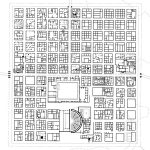Alexander von Humboldt (1769-1859) was a German geographer, explorer and naturalist who traveled extensively to Latin America and put the basis for a modern scientific description of the world. His research was published in a large series of volumes over 21 years. Fosterer of a holistic vision of the universe, Von Humboldt unified diverse branches of scientific knowledge and culture by collecting his research in a series of five volumes under the name of Kosmos, (1845–62), a publication extensively translated all over the world.
The writing was based on a series of lectures that Von Humboldt gave at the University of Berlin. The first volume conveys a “portrait of nature”, the second a general history of science. The theoretical framework was based on the view of the orderliness of the cosmos, directly borrowed from ancient Greek philosophy, by which the laws of the Universe apply also on the apparent chaos of the Earth. The general harmony of the cosmos offers to the person who contemplates it, personal inspiration and a beneficial awareness about life.
The writing was based on a series of lectures that Von Humboldt gave at the University of Berlin. The first volume conveys a “portrait of nature”, the second a general history of science. The theoretical framework was based on the view of the orderliness of the cosmos, directly borrowed from ancient Greek philosophy, by which the laws of the Universe apply also on the apparent chaos of the Earth. To the person who contemplates it, the general harmony of the cosmos offers personal inspiration and a beneficial awareness about life.
The following images are the illustrations from the pirated version of Kosmos by Traott Bromme under the title “Atlas zu Alexander von Humboldt’s Kosmos” (Stuttgart 1861).
Related:
Andrea Wulf, The Invention of Nature
Humboldt Books, a wonderful Italian publishing house focusing on travel literature that draws inspiration from scientific explorations of the 18th and 19th centuries.




Leave a Reply